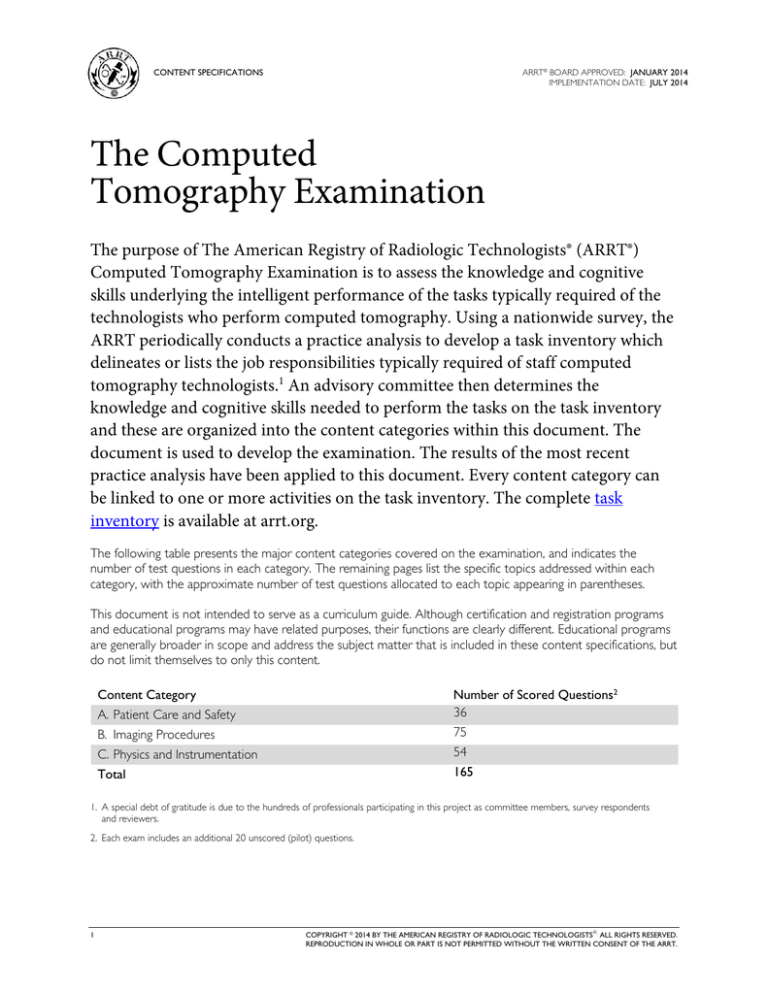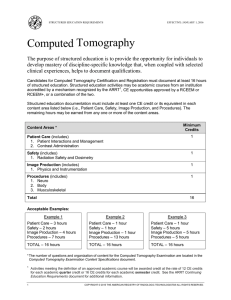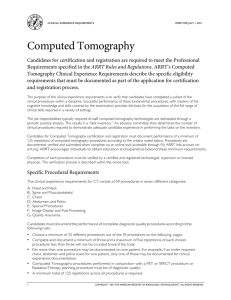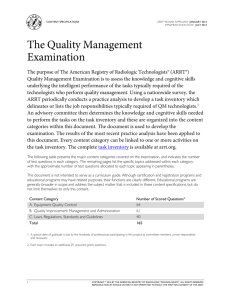
CONTENT SPECIFICATIONS
ARRT® BOARD APPROVED: JANUARY 2014
IMPLEMENTATION DATE: JULY 2014
The Computed
Tomography Examination
The purpose of The American Registry of Radiologic Technologists® (ARRT®)
Computed Tomography Examination is to assess the knowledge and cognitive
skills underlying the intelligent performance of the tasks typically required of the
technologists who perform computed tomography. Using a nationwide survey, the
ARRT periodically conducts a practice analysis to develop a task inventory which
delineates or lists the job responsibilities typically required of staff computed
tomography technologists.1 An advisory committee then determines the
knowledge and cognitive skills needed to perform the tasks on the task inventory
and these are organized into the content categories within this document. The
document is used to develop the examination. The results of the most recent
practice analysis have been applied to this document. Every content category can
be linked to one or more activities on the task inventory. The complete task
inventory is available at arrt.org.
The following table presents the major content categories covered on the examination, and indicates the
number of test questions in each category. The remaining pages list the specific topics addressed within each
category, with the approximate number of test questions allocated to each topic appearing in parentheses.
This document is not intended to serve as a curriculum guide. Although certification and registration programs
and educational programs may have related purposes, their functions are clearly different. Educational programs
are generally broader in scope and address the subject matter that is included in these content specifications, but
do not limit themselves to only this content.
Content Category
A. Patient Care and Safety
B. Imaging Procedures
C. Physics and Instrumentation
Number of Scored Questions2
36
75
54
Total
165
1. A special debt of gratitude is due to the hundreds of professionals participating in this project as committee members, survey respondents
and reviewers.
2. Each exam includes an additional 20 unscored (pilot) questions.
1
COPYRIGHT © 2014 BY THE AMERICAN REGISTRY OF RADIOLOGIC TECHNOLOGISTS. ALL RIGHTS RESERVED.
REPRODUCTION IN WHOLE OR PART IS NOT PERMITTED WITHOUT THE WRITTEN CONSENT OF THE ARRT.
CONTENT SPECIFICATIONS FOR
THE COMPUTED TOMOGRAPHY EXAMINATION
ARRT® BOARD APPROVED: JANUARY 2014
IMPLEMENTATION DATE: JULY 2014
A. Patient Care and Safety (36)
1. Patient Assessment and Preparation (8)
A. Clinical History
B. Scheduling and Screening
C. Education
D. Consent
E. Immobilization
F. Monitoring
1. level of consciousness
2. vital signs
3. heart rhythm and cardiac cycle
4. oximetry
G. Management of Accessory Medical Devices
1. oxygen delivery systems
2. chest tubes
3. in-dwelling catheters
H. Lab Values
1. renal function (e.g.,* BUN, eGFR,
creatinine)
2. blood coagulation (e.g., PT, PTT,
platelet, INR)
3. other (e.g., D-dimer, LFT)
I. Medications and Dosage
1. current (reconciliation)
2. pre-procedure medications
(e.g., steroid, anti-anxiety)
3. post-procedure instructions
(e.g., diabetic patient)
2. Contrast Administration (16)
A. Contrast Media
1. ionic, nonionic
2. osmolarity
3. barium sulfate
4. water soluble (iodinated)
5. air
6. water
7. other
B. Special Contrast Considerations
1. contraindications
2. indications
3. pregnancy
4. lactation
5. dialysis patients
* e.g., This is used here and in the remainder of this document to
indicate examples of the topics covered, but not a complete list.
2
A. Administration Route and Dose Calculations
1. IV
2. oral
3. rectal
4. intrathecal
5. catheters (e.g., peripheral line,
central line, PICC line)
6. other (e.g., stoma, intra-articular)
B. Venipuncture
1. site selection
2. aseptic and sterile technique
3. documentation (e.g., site, amount,
gauge, concentration, rate and number
of attempts)
C. Injection Techniques
1. manual
2. power injector options
a. single or dual head
b. single phase
c. multi-phase
d. flow rate
D. Post-Procedure Care
1. treatment of contrast extravasation
2. documentation
E. Adverse Reactions
1. recognition and assessment
2. treatment
3. documentation
(Section A continues on the following page.)
CONTENT SPECIFICATIONS FOR
THE COMPUTED TOMOGRAPHY EXAMINATION
ARRT® BOARD APPROVED: JANUARY 2014
IMPLEMENTATION DATE: JULY 2014
A. Patient Care and Safety (continued)
3. Radiation Safety and Dosimetry (12)
A. Technical Factors Affecting Patient Dose
1. kVp
2. mAs
3. pitch
4. collimation/beam width
5. multi-detector configuration
6. gating
B. Radiation Protection and Shielding
1. traditional (e.g., lead apron)
2. non-traditional (e.g., bismuth)
3
C. Dose Measurement
1. CT Dose Index (CTDI)
2. Dose Length Product (DLP)
3. documentation
D. Patient Dose Reduction and Optimization
1. pediatric
2. adult
3. dose modulation techniques
(e.g., SMART mA, auto mA, CARE dose,
and SURE exposure)
4. iterative reconstruction
CONTENT SPECIFICATIONS FOR
THE COMPUTED TOMOGRAPHY EXAMINATION
ARRT® BOARD APPROVED: JANUARY 2014
IMPLEMENTATION DATE: JULY 2014
B. Imaging Procedures (75)
TYPE OF STUDY
FOCUS OF QUESTIONS
1. Head (13)
A. Cranial Nerves
B. Internal Auditory Canal
C. Temporal Bones
D. Pituitary
E. Orbits
F. Sinuses
G. Maxillofacial
H. Temporomandibular Joint
I. Posterior Fossa
J. Brain
K. Cranium
L. Vascular
Questions about each of the studies listed on the left
may focus on any of the following relevant factors:
2. Neck (5)
A. Larynx
B. Soft Tissue Neck
C. Vascular
3. Chest (15)
A. Mediastinum
B. Lung
C. Heart
D. Airway
E. Vascular
4. Abdomen (25)
A. Liver
B. Biliary
C. Spleen
D. Pancreas
E. Adrenals
F. Kidneys and/or Ureters
G. GI Tract
H. Vascular
4
1. Sectional Anatomy
• sagittal plane
• transverse plane (axial)
• coronal plane
• off-axis (oblique)
• landmarks
• pathology recognition
2. Contrast Media
• types of agents
• indications
• contraindications
• dose calculation
• administration route
• scan/prep delay (e.g., bolus timing, test bolus)
3. Imaging Processes
• isocentric positioning
• scout
• acquisition methods (e.g., volumetric, axial
or sequential)
• parameter selection (e.g., image thickness,
mA, time, algorithm, pitch)
• protocol modification for pathology or trauma
4. Special Procedures
• 3D studies
• biopsies
• radiation therapy planning
• drainage
• colonography or virtual colonography
• brain perfusion studies
• transplant studies
• screening
(Section B continues on the following page.)
CONTENT SPECIFICATIONS FOR
THE COMPUTED TOMOGRAPHY EXAMINATION
ARRT® BOARD APPROVED: JANUARY 2014
IMPLEMENTATION DATE: JULY 2014
B. Imaging Procedures (continued)
TYPE OF STUDY
FOCUS OF QUESTIONS
5. Pelvis (6)
A. Bladder
B. Colorectal
C. Reproductive Organs
D. Vascular
Questions about each of the studies listed on the left
may focus on any of the following relevant factors:
6. Musculoskeletal (11)
A. Upper Extremity
B. Lower Extremity
C. Spine
D. Pelvis and/or Hips
E. Shoulder Girdle
F. Sternum and/or Ribs
G. Vascular
H. Post Myelography
I. CT Arthrography
J. Diskography
1. Sectional Anatomy
• sagittal plane
• transverse plane (axial)
• coronal plane
• off-axis (oblique)
• landmarks
• pathology recognition
2. Contrast Media
• types of agents
• indications
• contraindications
• dose calculation
• administration route
• scan/prep delay (e.g., bolus timing, test bolus)
3. Imaging Processes
• isocentric positioning
• scout
• acquisition methods (e.g., volumetric, axial
or sequential)
• parameter selection (e.g., image thickness,
mA, time, algorithm, pitch)
• protocol modification for pathology or trauma
4. Special Procedures
• 3D studies
• biopsies
• radiation therapy planning
• drainage
• colonography or virtual colonography
• brain perfusion studies
• transplant studies
• screening
5
CONTENT SPECIFICATIONS FOR
THE COMPUTED TOMOGRAPHY EXAMINATION
ARRT® BOARD APPROVED: JANUARY 2014
IMPLEMENTATION DATE: JULY 2014
C. Physics and Instrumentation (54)
1. Radiation Physics (4)
A. Radiation Interaction with Matter
B. Acquisition (geometry)
C. Physical Principles (attenuation)
2. CT System Principles, Operation, and
Components (14)
A. Tube
1. kVp
2. mA
3. warm-up procedures
B. Generator
C. Detector Configuration
D. Data Acquisition Systems (DAS)
E. Collimation/Beam Width
F. Computer and Array Processor
3. Image Processing (10)
A. Reconstruction
1. filtered backprojection reconstruction
2. iterative reconstruction
3. interpolation
4. reconstruction algorithm
5. raw data versus image data
6. prospective/retrospective reconstruction
7. reconstruction interval
B. Post-Processing
1. Multi-Planar Reformation (MPR)
2. 3D rendering (MIP, SSD, VR)
3. quantitative analysis (e.g., distance, diameter,
calcium scoring, ejection fraction)
6
4. Image Display (10)
A. Pixel, Voxel
B. Matrix
C. Image Magnification
D. Field of View (scan, reconstruction, and display)
E. Window Level, Window Width
F. Cine
G. ROI (e.g., mean, Standard Deviation [SD])
5. Informatics (2)
A. Hard/Electronic Copy (e.g., DICOM file format)
B. Archive
C. PACS
D. Security and Confidentiality
E. Networking
6. Image Quality (9)
A. Spatial Resolution
B. Contrast Resolution
C. Temporal Resolution
D. Noise and Uniformity
E. Quality Assurance
F. CT Number (Hounsfield units)
G. Linearity
7. Artifact Recognition and Reduction (5)
A. Beam Hardening or Cupping
B. Partial Volume Averaging
C. Motion
D. Metallic
E. Edge Gradient
F. Patient Positioning (out-of-field)
G. Equipment Induced
1. rings
2. streaks
3. tube arcing
4. cone beam
5. capping
V 2015.05.21




